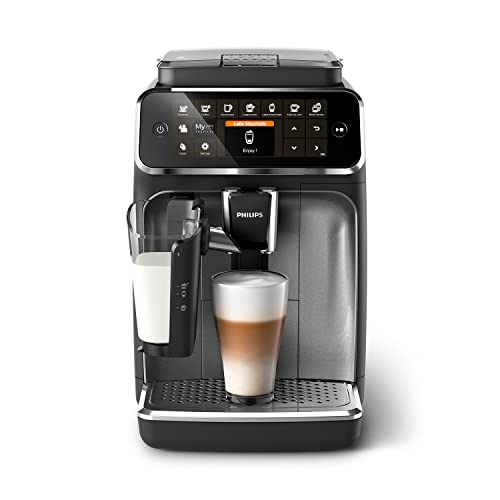20 Myths About Coffee Machine Beans: Busted
페이지 정보
작성자 Chau 작성일23-12-21 03:44 조회3회 댓글0건본문
 Whole bean coffee maker Coffee Machine Beans
Whole bean coffee maker Coffee Machine BeansIf your customers are concerned about their environmental impact they may be shocked to learn that whole-bean to cup automatic coffee machine coffee machines generate a lot waste in the form of grounds.
Beans have a great flavour and can be stored for a long period in an airtight, dark container.
1. Roasted Beans
When coffee beans are first harvested they're green and aren't able to make your morning cup until they are roasted. Roasting is a sophisticated chemical process that turns raw beans into deliciously flavorful delicious, aromatic coffee that we drink every day.
There are several different types of roasts that determine how strong and delicious the brewed coffee will be. The various roast levels are determined by the length of time the beans are roasted. They also impact the amount of caffeine in the beverage.
Light roasts are roasted for the in the shortest amount of time and are distinguished by their light brown color. They also lack oil on the beans. At about 350o-400o the beans begin to steam as their internal water vapors start to release. The first crack will be heard soon after. The first crack means that the beans are close to the end of their roasting and that they will be ready for brewing in a short time.
During the roasting process sugars are caramelized and aromatic compounds are formed. These nonvolatile and volatile compounds give coffee its characteristic flavor and aroma. It is essential not to over-roast the beans during this time as they could lose their distinctive flavor or even turn bitter. After the roasting has been completed, the beans are cooled in a cool air flow or water.
2. Water Temperature
When brewing coffee the water temperature is one of the most important factors. You can end up with bitter coffee when you use too hot water. If you use water that is too cold it will result with weak, or bitter, coffee. A good guideline is to use water that has been filtered or bottled, when needed, and heat your equipment prior to beginning to brew.
The hotter the water, the faster it will dissolve things such as flavor compounds and oils from the coffee grounds. The ideal temperature to brew coffee machine bean is between 195 and 205 degrees Fahrenheit. This is just below boiling point. This range is a popular option for coffee professionals from all over the world, and it works well across all brewing methods.
The exact temperature of the brewing process is not always accurate, as some heat is lost via the process of evaporation. This is especially the case for manual methods like pour-over and French press. Additionally, different equipment for brewing could have different amounts of thermal mass and materials that can affect the final brew temperature.
In general generally, a higher brew temperature makes a stronger cup coffee, but this isn't always the case for all sensory aspects. Some research suggests that bitter, chocolate, roast, and ashy flavors are more intense when you use high temperatures of brewing, whereas other tastes like sourness are less intense with increasing temperature.
3. Grind
The best beans, the most perfect roast and the freshest filtering water won't yield an outstanding cup if grind is not handled correctly. The size of the beans is a key element in determining the flavor as well as the strength and extraction rate. It is crucial to be in control of this factor in order to test recipes and ensure consistency.
Grind size is the particle size of the ground beans after they've been crushed. Depending on the brewing method, different grind sizes will be optimal. For instance, coarsely-ground fresh beans coffee machine; please click www.haim.kr, will make an espresso drink that is weak and a more finely-ground grind will yield an espresso that is bitter.
When selecting a grinder for coffee, it is crucial to look for models that offer uniform grinding to ensure maximum consistency. Burr grinder is a great way to achieve this and ensures that the coffee grounds are of an equal size. Blade grinders can be uneven and can result in uneven grounds.
People who want to get the most of their espresso maker should consider buying a bean-to-cup maker with an integrated grinder and brewing unit. This will allow the beans to be brewed at the peak of their freshness and eliminate the requirement for Fresh beans coffee Machine ground coffee bean to cup machine that has been pre-ground. Melitta Bialetti Mypresso offers all of these features in a stylish and contemporary package. It comes with a variety of recipes, eight user profiles that can be customised and an application for smartphones that provides complete control. It comes with a dual-hopper and is compatible with ground and whole beans.
4. Brew Time
If the brew time is too short it could result in underextraction. If you make it too long, you could risk overextraction. This can cause bitter compounds that ruin the sweet flavors and sugars in your cup and Fresh Beans Coffee Machine leave it with bitter and sour taste.
If your coffee brewing time is too long, you will lose that sweet spot of optimal extraction. This can result in weak watery coffee that could be overly acidic and unpleasant to drink. The amount of coffee ground, the size of the grind and the method of brewing determine the best brewing time.
The top bean to cup machines usually have a high-quality grinder with a variable settings. This allows you to play with brew durations and water temperatures until you discover the perfect blend of your coffees.
 The process of brewing requires more energy per unit of coffee than any other step of the supply chain. Therefore, it is important to understand how to control the temperature of brewing to minimize waste and improve the taste. It is still difficult to control the extraction process with precision. This is due in part to the distribution of particles and the kinetics of dissolution and roasting as well as the characteristics of the water etc. This study examined the variation of each of these parameters and measured TDS and PE to assess how they affected the sensory profile of the coffee. The TDS and PE values were both low even though there was some variation between the brews, possibly due to channelling.
The process of brewing requires more energy per unit of coffee than any other step of the supply chain. Therefore, it is important to understand how to control the temperature of brewing to minimize waste and improve the taste. It is still difficult to control the extraction process with precision. This is due in part to the distribution of particles and the kinetics of dissolution and roasting as well as the characteristics of the water etc. This study examined the variation of each of these parameters and measured TDS and PE to assess how they affected the sensory profile of the coffee. The TDS and PE values were both low even though there was some variation between the brews, possibly due to channelling.댓글목록
등록된 댓글이 없습니다.





